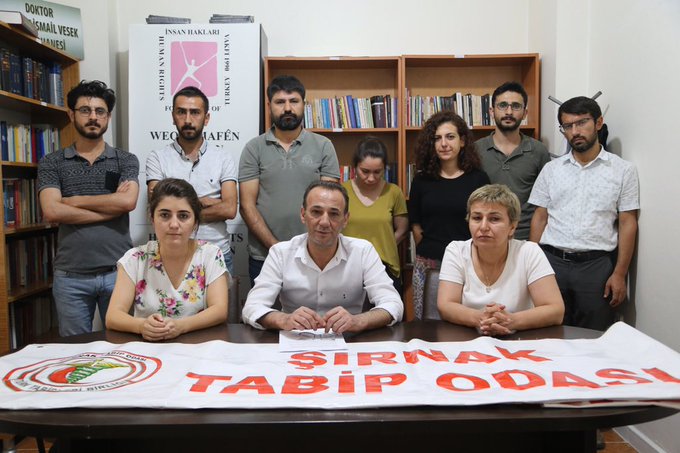Şırnak Tabip Odası, İHD Şırnak Şubesi, SES Şırnak Şubesi ve TİHV Cizre Referans Merkezi olarak halkın sağlık hakkını, hekimlik değerlerini savunmaya devam edeceğiz. Dün (5 Ağustos 2019) gerçekleştirdiğimiz ortak açıklamamız aşağıdadır:
Şırnak-Cizreʼde 2 Ağustos 2019 Cuma günü sabah saatlerinde 1 hekim 3 hemşire sağlık çalışanı sokağa çıkma yasaklarının sürdüğü dönemde yaralı olarak gelen 10 yaşındaki bir çocuğa sağlık hizmeti sunduğu iddiası ile evleri basılarak gözaltına alınmıştı. Sokağa çıkma yasaklarının devam ettiği süreç boyunca sağlık hizmetine erişimin engellendiği ve neredeyse imkansız olduğu koşullarda suçlayıcı iddia “10 yaşındaki bir çocuğa sağlık hizmeti vermiş olmak”: Bundan dolayı sağlık emekçisi arkadaşlarımız tutuklanmışlardır.
Hekimliğin evrensel etik değerlerine sahip çıkarak; iyi hekimlik uygulaması ve temel görevleri sağlık hizmeti sunmak olan sağlık emekçilerinin mesleki sorumluklarını onurlu şekilde yaptıkları için gözaltına alınmalarını kabul etmiyoruz. Sağlık hizmeti sunanlar mesleki yükümlülerini yerine getirmişlerdir. Fakat bizler biliyoruz ki, daha önce de Cizre Ambulans davasında tüm hukuksuzluklara rağmen arkadaşlarımızın onurlu duruşu sayesinde yaralıya müdahalenin suç sayılamayacağı gerçeği açığa çıkarılmıştır. Sağlık çalışanları hastanın; inanç, etnik köken, cinsiyet, milliyet, politik düşünce, ırk, cinsel yönelim, ya da başka herhangi bir özelliğine bakmaksızın savaş alanında, çatışmalı durumlarda bile sağlık hizmeti sunar, tarafsız davranır ve ihtiyacı olana sağlık hizmeti sunar.
Şırnak Tabip Odası, İHD, SES ve TİHV Cizre Referans Merkezi olarak halkın sağlık hakkını, hekimlik değerlerini savunmaya, geçmiş geleneğimizde olduğu gibi bugün de ölüme karşı yaşamdan ve savaşa karşı barıştan yana olma tutumumuzu sürdürmeye devam edeceğiz.
Bu tutuklama sürecinin esas konusu ulusal ve uluslararası hukuk ve sözleşmelerin evrensel etik kurallar ve vicdandır.
Sağlık çalışanı arkadaşlarımızın maruz bırakıldığı bu hukuksuz uygulama DERHAL sonlandırılmalıdır.
Şırnak Tabip Odası
SES Şırnak Şubesi
TİHV Cizre Referans Merkezi
İHD Şırnak Şubesi

